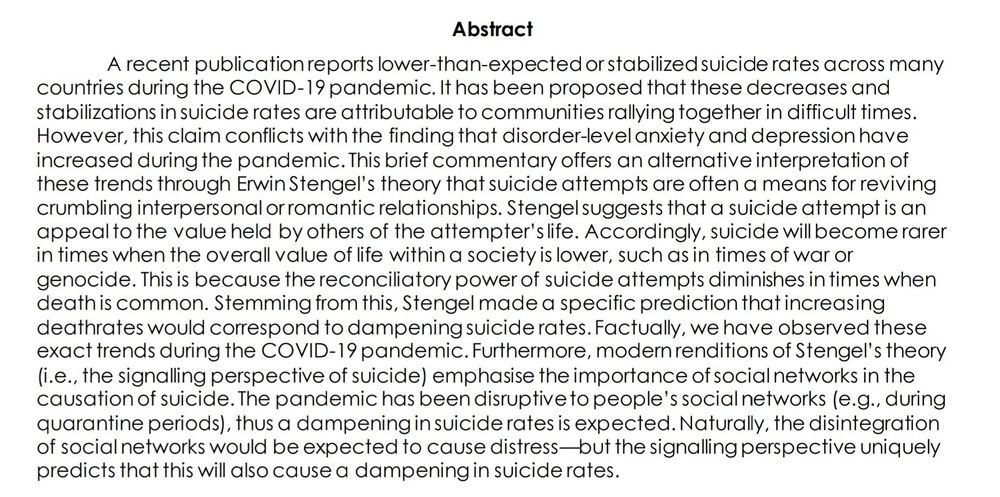
James Wiley
@jamescwiley.bsky.social
Statistician | Independent researcher | interests include evolutionary biology, suicide, psychology, and philosophy of science. Opinions expressed are my own.
ORCiD: https://orcid.org/0000-0002-5049-573X
ORCiD: https://orcid.org/0000-0002-5049-573X
Maybe of interest, I've been looking at the other side of the same coin—that suicide rates get censored by increases in other-cause mortality. Suicide rates increase with declining death rates coming out of the flu season, with COVID providing a nice natural experiment:
osf.io/preprints/ps...
osf.io/preprints/ps...

November 6, 2025 at 3:29 PM
Maybe of interest, I've been looking at the other side of the same coin—that suicide rates get censored by increases in other-cause mortality. Suicide rates increase with declining death rates coming out of the flu season, with COVID providing a nice natural experiment:
osf.io/preprints/ps...
osf.io/preprints/ps...
The COVID natural experiment suggests something very different. Suicide rates increase with declining death rates coming out of the flu season. When death rates are disrupted, suicide rates are also disrupted:
osf.io/preprints/ps...
osf.io/preprints/ps...

September 30, 2025 at 11:36 PM
The COVID natural experiment suggests something very different. Suicide rates increase with declining death rates coming out of the flu season. When death rates are disrupted, suicide rates are also disrupted:
osf.io/preprints/ps...
osf.io/preprints/ps...

July 7, 2025 at 4:30 PM
The recommended prompts it gave were also gold:

July 1, 2025 at 2:16 AM
The recommended prompts it gave were also gold:
I wonder what they’re suggesting here? ☹

July 1, 2025 at 2:16 AM
I wonder what they’re suggesting here? ☹
The model seems to be overtrained on erratic online discourse 🤔

July 1, 2025 at 2:16 AM
The model seems to be overtrained on erratic online discourse 🤔
I totally broke a ChatGPT guardrail today:

July 1, 2025 at 2:16 AM
I totally broke a ChatGPT guardrail today:
4/7 I then test whether the pre-pandemic correlation between death rates and suicide rates can predict the 2020 suicide rates. Results are good:

May 2, 2025 at 12:26 PM
4/7 I then test whether the pre-pandemic correlation between death rates and suicide rates can predict the 2020 suicide rates. Results are good:
3/7 In 2020, the seasonal pattern for death rates was disrupted due to inordinate deaths occurring at an atypical time of year. Suicide rates show an exact inverse break in their seasonality relative to death rates. Is this just a coincidence? 🤔

May 2, 2025 at 12:26 PM
3/7 In 2020, the seasonal pattern for death rates was disrupted due to inordinate deaths occurring at an atypical time of year. Suicide rates show an exact inverse break in their seasonality relative to death rates. Is this just a coincidence? 🤔
2/7 The analysis reveals a consistent inverse seasonal relationship between death rates and suicide rates.

May 2, 2025 at 12:26 PM
2/7 The analysis reveals a consistent inverse seasonal relationship between death rates and suicide rates.
3. I then applied this model to predict 2020 suicide rates based on 2020 death rates. The predictions explained 11.6% of the variation in actual 2020 suicide rates and follow the average trend closely.

December 15, 2024 at 4:16 PM
3. I then applied this model to predict 2020 suicide rates based on 2020 death rates. The predictions explained 11.6% of the variation in actual 2020 suicide rates and follow the average trend closely.
2. Using Canadian suicide rates from 2010-2019, I found that suicide rates decrease by an average of 0.27 standard deviations for every 1 standard deviation increase in death rates.

December 15, 2024 at 4:16 PM
2. Using Canadian suicide rates from 2010-2019, I found that suicide rates decrease by an average of 0.27 standard deviations for every 1 standard deviation increase in death rates.
1. Preprint update: presenting new data analysis supporting Stengel’s hypothesis that suicide rates decline when societal value of life decreases, such as during periods of higher mortality.
osf.io/preprints/ps...
osf.io/preprints/ps...

December 15, 2024 at 4:16 PM
1. Preprint update: presenting new data analysis supporting Stengel’s hypothesis that suicide rates decline when societal value of life decreases, such as during periods of higher mortality.
osf.io/preprints/ps...
osf.io/preprints/ps...
To your point about declining quality of life, I wrote a brief commentary on Stengel's hypothesis that suicide rates decrease during times of societal suffering, like war or genocide. I argue this applies to the pandemic as well. You can read here: osf.io/preprints/ps...

December 1, 2024 at 5:21 AM
To your point about declining quality of life, I wrote a brief commentary on Stengel's hypothesis that suicide rates decrease during times of societal suffering, like war or genocide. I argue this applies to the pandemic as well. You can read here: osf.io/preprints/ps...
4/ As the plots show, results may hinge on one or two key data points. To explore this limitation, I performed a jackknife replication—removing one observation at a time to assess the impact.

November 23, 2024 at 3:53 PM
4/ As the plots show, results may hinge on one or two key data points. To explore this limitation, I performed a jackknife replication—removing one observation at a time to assess the impact.
2/ I tested the hypothesis:
Ha: Reproduction is related to regional suicide rates for individuals with mental health conditions.
Two versions of the analysis were conducted for validation:
Using 4-year suicide rates
Using 2-year suicide rates
Ha: Reproduction is related to regional suicide rates for individuals with mental health conditions.
Two versions of the analysis were conducted for validation:
Using 4-year suicide rates
Using 2-year suicide rates

November 23, 2024 at 3:53 PM
2/ I tested the hypothesis:
Ha: Reproduction is related to regional suicide rates for individuals with mental health conditions.
Two versions of the analysis were conducted for validation:
Using 4-year suicide rates
Using 2-year suicide rates
Ha: Reproduction is related to regional suicide rates for individuals with mental health conditions.
Two versions of the analysis were conducted for validation:
Using 4-year suicide rates
Using 2-year suicide rates
1/ New preprint: "Do regional suicide rates predict reproductive fitness in individuals with mental health conditions?"
A theory-driven hypothesis explored with limited data. Analysis will continue as more data become available from statistical agencies.
osf.io/preprints/os...
A theory-driven hypothesis explored with limited data. Analysis will continue as more data become available from statistical agencies.
osf.io/preprints/os...

November 23, 2024 at 3:53 PM
1/ New preprint: "Do regional suicide rates predict reproductive fitness in individuals with mental health conditions?"
A theory-driven hypothesis explored with limited data. Analysis will continue as more data become available from statistical agencies.
osf.io/preprints/os...
A theory-driven hypothesis explored with limited data. Analysis will continue as more data become available from statistical agencies.
osf.io/preprints/os...
Stigma against mental illness encourages suicide.
Stigma against suicide discourages suicide.
How do we reconcile these findings? Here's my take: osf.io/preprints/ps...
Stigma against suicide discourages suicide.
How do we reconcile these findings? Here's my take: osf.io/preprints/ps...

November 20, 2024 at 10:06 AM
Stigma against mental illness encourages suicide.
Stigma against suicide discourages suicide.
How do we reconcile these findings? Here's my take: osf.io/preprints/ps...
Stigma against suicide discourages suicide.
How do we reconcile these findings? Here's my take: osf.io/preprints/ps...

